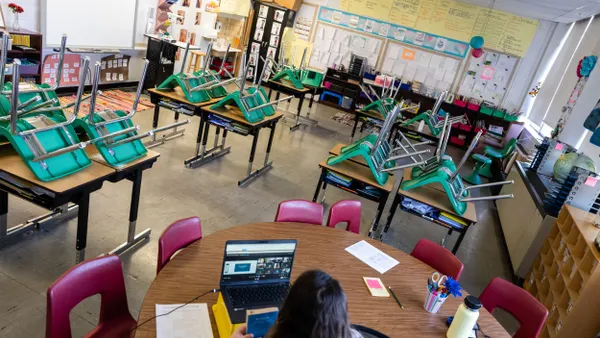School systems aiming to increase attendance rates are moving away from punitive approaches in favor of prevention and problem-solving strategies, attendance experts said in a webinar hosted by Attendance Works last week.
Some of those newer strategies include analyzing data to better target interventions, adjusting truancy policies and building strong parent-school relationships with current families and even brand new parents, said webinar participants. The Wednesday webinar was part of a series of sessions to raise attendance awareness as the 2023-24 school year gets underway.
Chronic absenteeism rates are higher than ever nationally, although final national statistics for the 2022-23 school year are still pending, said Hedy Chang, executive director of Attendance Works, which promotes efforts to reduce chronic absenteeism. Early data shows rates remain high compared to pre-pandemic tallies, particularly for early elementary and high school students.
Attendance Works defines chronic absenteeism as a student missing 10% or more of school days due to absence for any reason.
Chang, along with researchers, advocates and educators, discussed efforts — particularly family engagement and trauma-informed approaches — that are helping schools decrease chronic absenteeism.
"The key to solving this problem is shifting our mindset" from a compliance-focused approach centered on excused and unexcused absences to a prevention, problem-solving, and family engagement perspective, Chang said. All absences matter and result in missed learning, she said.
The Yoncalla School District in Oregon, for example, hosts baby showers and playdates for families with young children as part of a larger effort to increase family participation from the start and eventually student attendance, said Erin Helgren, principal of Yoncalla Elementary School.
Other approaches from the 255-student district and its partners include home visits to elementary school families, a closet full of clothing and school supplies available to all families, increased access to medical services, and expanded after-school youth sports programs.
Additionally, the two-school rural district increased family engagement by creating roles for families to serve on committees at the school and district levels.
The efforts are paying off in better school attendance, Helgren said. Whereas 93% of kindergartners and 71% of elementary students overall were chronically absent in the 2021-22 school year, those numbers dropped to 78% for kindergartners and 49% schoolwide in 2022-23.
"The very first thing that we did is we really listened to the community and asked the community, 'What are some of the things that we can do to support connection?'" Helgren said.
Turning to attendance interventions
In Kansas, the Kansas City Public Schools took a similar approach to boost attendance by talking with families to better understand their needs and the barriers causing students to miss school, said Naomi Tolentino, coordinator of student support programs for the district.
The 22,000-student district, which has 50 schools and centers, also boosted professional development and direct coaching for staff. That training encouraged use of a multi-tiered systems of support to address the attendance needs of all students, including those with high rates of absences.
"We just do a lot of professional development and we talk about the importance of building relationships" and the impact that has on attendance, Tolentino said.
It also converted a districtwide team that had focused on punishments for truancy to one that now looks at prevention, intervention and incentives for strong attendance. Each school also created attendance teams that analyze data to develop interventions based on areas of need, Tolentino said.
Additionally, schools are working with families to develop student success plans for students who were chronically absent the previous school year to make sure attendance goals are met and that families and staff are supportive of interventions.
As a result of this work, the district has reduced its chronic absenteeism rate by 14 percentage points, from 50% in 2019 to 36% in 2023.
"We've been working very hard to put things in place as a system," said Tolentino. "We still have a lot of work to do.”












